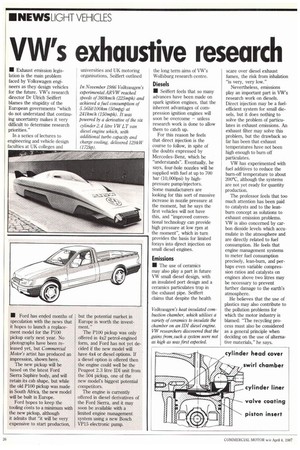VW's exhaustive research
Page 28

If you've noticed an error in this article please click here to report it so we can fix it.
• Exhaust emission legislation is the main problem faced by Volkswagen engineers as they design vehicles for the future. VW's research director Dr Ulrich Seiffert blames the stupidity of the European governments "which do not understand that continuing uncertainty makes it very difficult to determine research priorities."
In a series of lectures to engineering and vehicle design faculties at UK colleges and universities and UK motoring organisations, Seiffert outlined In November 1986 Volkswagen's experimental ARVW reached speeds of 360km1h (225mph) and achieved a fuel consumption of 5.561it1100km (50mpg) at 241km1h (150mph). It was powered by a derivative of the six cylinder 2.4 litre VW LT van diesel engine which, with additional turbo capacity and charge cooling, delivered 129kW (172hp) the long term aims of VW's Wolfsburg research centre.
Diesels
• Seiffert feels that so many advances have been made on spark ignition engines, that the inherent advantages of compression ignition engines will soon be overcome — unless research work is done to allow them to catch up.
For this reason he feels that direct injection is the course to follow, in spite of the doubts expressed by Mercedes-Benz, which he "understands". Eventually, he says, four-hole nozzles will be supplied with fuel at up to 700 bar (10,000psi) by highpressure pump/injectors. Some manufacturers are looking for this sort of massive increase in nozzle pressure at the moment, but he says the first vehicles will not have this, and "improved conventional technology can provide high pressure at low rpm at the moment", which in turn provides the basis for limited forays into direct injection on small diesel engines.
Emissions
• The use of ceramics may also play a part in future VW small diesel design, with an insulated port design and a ceramics particulates trap in the exhaust pipe. Seiffert claims that despite the health scare over diesel exhaust fumes, the risk from inhalation "is very, very low."
Nevertheless, emissions play an important part in VW's research work on diesels. Direct injection may be a fuelefficient system for small diesels, but it does nothing to solve the problem of particulates in exhaust emissions. An exhaust filter may solve this problem, but the drawback so far has been that exhaust temperatures have not been high enough to burn off particulates.
VW has experimented with fuel additives to reduce the burn-off temperature to about 200°C, although the systems are not yet ready for quantity production.
The professor feels that too much attention has been paid to catalysts and to the leanburn concept as solutions to exhaust emission problems. VW is also concerned by carbon dioxide levels which accumulate in the atmosphere and are directly related to fuel consumption. He feels that engine management systems to meter fuel consumption precisely, lean-burn, and perhaps even variable compression ratios and catalysts on engines above two litres may be necessary to prevent further damage to the earth's atmosphere.
He believes that the use of plastics may also contribute to the pollution problems for which the motor industry is blamed: "The recycling process must also be considered as a general principle when deciding on the use of alternative materials," he says.




















































































